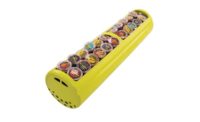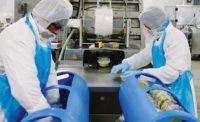Evolution Fresh Enhances the Premium Juice Market with HPP Technology




























Juicing has become quite the trend for today’s health-conscious consumers, and quite a mess to clean up as well. However, many at-home juicing techniques still leave the end product a bit clumpy. That’s why Evolution Fresh, a Starbucks brand, is today’s go-to solution for cold-pressed, high-pressure processed (HPP) juices and smoothies. (Go to How Evolution Fresh Redefines the Super-Premium Juice Market to learn more about the evolution of this national cold-pressed juice processor).
But, it’s the employment of HPP technology that separates this Rancho Cucamonga, Calif.-based company from the others. That’s why Refrigerated & Frozen Foods named Evolution Fresh as its 2015 Refrigerated Foods Processor of the Year.
Take a tour of the new $70 million, 265,000-square-foot Rancho Cucamonga juicery, what is said to be the largest HPP juicery (based on sales) in the United States that sources, peels, squeezes and presses many of the raw fruits and vegetables used in its juices on site.
How HPP helps redefine juice processing
At the time of Refrigerated & Frozen Foods’ visit, the Rancho Cucamonga juicery was producing one of its organic greens juices, which includes spinach, parsley, celery, romaine lettuce, kale and cucumbers.
Outside the juicery, citrus loads are dropped off daily by farmers located within 400 miles of the Rancho Cucamonga site. After a load passes a rigorous inspection, it goes through a sorting process where partners (employees) pull out any defective fruit. Any discarded fruit is carried off to be used for cattle feed for local farmers.
Come time for processing, the good citrus is delivered into a conveying system that performs a series of washes to remove dust, debris and foreign material. Then, a bucket elevator conveys the loads into an accumulator before entering another washing phase prior to entering the facility.
The citrus then conveys inside the juicery, where another set of partners manually sort the fruit one last time before it enters one of the many extractors.
Meanwhile, in the vegetable processing room, fresh vegetables come in through a cooler set at 36-42°F. On one line, partners load a batch of celery, while another line consists of partners cutting and prepping fresh beets. A third line entails partners chopping organic lettuce. All three lines convey via a screw conveyor into a washing bin, and then drop onto a vibratory conveyor that travels into the pressing room, where all of the vegetables are blended together.
After blending together, the vegetables enter a grinder before dropping into a press, where the batch is squeezed into juice.
“That juice is kept cold, put into a day tank and then put into a batch for blending,” says Kavien Martin, director, supply chain operations. “If you try this [process] at home, you’re going to get a lot more particulates in your product. Here, with a grinder and a press, we’re basically taking the particulates out and you’re left with clean juice.”
The freshly squeezed juice flows through tubes into the tank farm, which is home to several clean-in-place tanks ranging from 100 to 12,000 gallons.
All fillers run simultaneously at all times. The Rancho Cucamonga juicery runs five sized bottles. At the time of Refrigerated & Frozen Foods’visit, the filling room was running gallon bottles and 50-point stock.
The bottle caps arrive from an outside room, then travel into a capping machine that automatically applies the caps to the bottles after they’re filled. Meanwhile, bottles feed through a bottle rinser, are then inverted, rinsed, inverted, drained, then inverted back right side up prior to being filled. Once capped, the bottles convey into the HPP room.
Here, an accumulator seizes the bottles and places them in crates. Then, a partner manually loads each bottle into the HPP chambers, which runs through one of the HPP machines that apply about 87,000 pounds of pressure per cycle.
Then, the bottles convey into the packing operation, where product is packed and cubed into full pallet quantities.
The Rancho Cucamonga juicery runs 24 hours a day, five days a week, including daily line sanitation.
Transforming with today’s trends
Oct. 1, 2014 marked the 1-year anniversary of the opening of the Rancho Cucamonga juicery. Since then, it continues to evolve with today’s trends.
For starters, the Rancho Cucamonga juicery received a Superior rating from its SAI Global audit, and maintains a sophisticated worker safety and food safety training program.
“The training begins Day 1 with every partner as they attend an all-day training session covering all aspects of food quality and personal safety,” says Brian Jameson, vice president, supply chain operations. “Once in their assignment, they continue to receive periodic training updates and are also encouraged to participate in one of the juicery’s engagement teams that focus in those areas.”
In partnership with its corporate sustainability team, the Rancho Cucamonga juicery installed fuel cells to reduce its demand on the power grid.
Keeping up with demand for cold-pressed juice
To keep up with the ever-growing demand for cold-pressed juice, Evolution Fresh partners with suppliers who share similar values and visions.
“Beginning with our fresh fruit and vegetable suppliers into our juicery teams through the transportation network to our customers, every link in the supply chain is critical to achieving high-quality juice,” says Jameson.
Within the juicery, the supply chain functions the same for retail and foodservice. The majority of raw materials are sourced within 400 miles of the juicery, except for exotic fruits such as limes, coconuts and pineapples and other items not available in Southern California, which then come from Mexico, Thailand and the Philippines.
“The biggest challenge we face is Mother Nature providing optimal weather conditions year-round for an abundance of the best fruit and vegetables,” adds Jameson. “Due to changing weather conditions, our team develops relationships with farms in multiple geographies to ensure we have the best products consistently meeting our customer expectations.”
Furthermore, Evolution Fresh utilizes several different distribution methods. These options range from full truckload quantities shipped to internal distribution points, LTL shipments directly to customers’ locations and a direct-store delivery program, where Evolution Fresh partners actually stock product on customers’ shelves.
“Because our product is highly perishable, no matter what distribution system we utilize, stringent temperature monitoring is in place for all shipments to ensure that product is maintained below 40°F,” adds Jameson.
Logistics initiatives in place for 2015 include installing a real-time GPS and temperature monitoring system for pickup and delivery vehicles, converting some of the fleet trailers to electrical supply, thus leveraging the company’s on-site electrical fuel cells and scouring the planet for new ingredients.
“We were one of the first juice companies to employ the HPP juice technology,” adds Jameson. “Leveraging Starbucks’ unique model—retail footprint, CPG grocery distribution channels, digital breadth and in-depth customer engagement—we are able to redefine and grow the super-premium juice market.”
Go here to check out the full photo gallery of the Rancho Cucamonga, Calif., juicery.
Also, CLICK HERE to learn more about the company and its mission to redefine the super-premium juice market.
Looking for a reprint of this article?
From high-res PDFs to custom plaques, order your copy today!




















